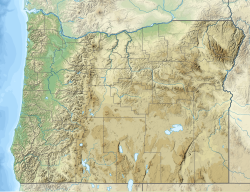| Mahogany Mountain | |
|---|---|
 Leslie Gulch rock spire, Mahogany Mountain, Oregon. Photo: BLM (2008). | |
| Highest point | |
| Elevation | 6,526 ft (1,989 m) NAVD 88 [1] |
| Prominence | 1,892 ft (577 m) [2] |
| Coordinates | 43°14′06″N117°15′21″W / 43.234976817°N 117.255852547°W [1] |
| Geography | |
| Location | Malheur County, Oregon, U.S. |
| Parent range | Owyhee Mountains |
| Topo map | USGS McCain Creek |
| Geology | |
| Last eruption | 15.5 million years ago |


Mahogany Mountain is an ancient caldera volcano on the border of Oregon and Idaho, in Malheur County and Owyhee County, respectively. While its early history is largely unknown, its last eruption was probably 15.5 million years ago. This eruption ejected layers of rhyolite and produced tuff, creating formations of rock in the Leslie Gulch.
Contents
Nearby features include the Owyhee River, historically used as a fishing and camping ground for early Native Americans. The climate of the area tends to be extreme; that is, it is cold in the winter and hot in summer. Sparse vegetation is present, including shrubs and patches of juniper.

